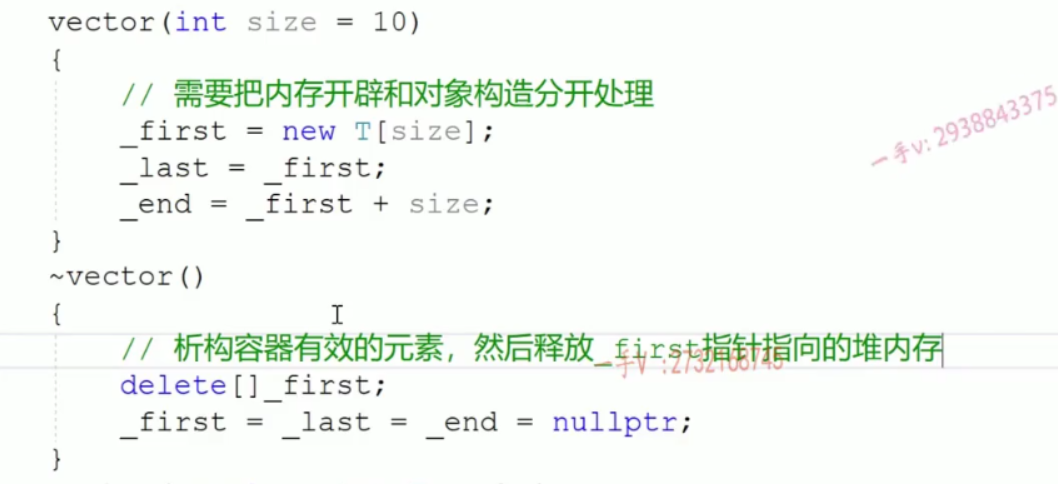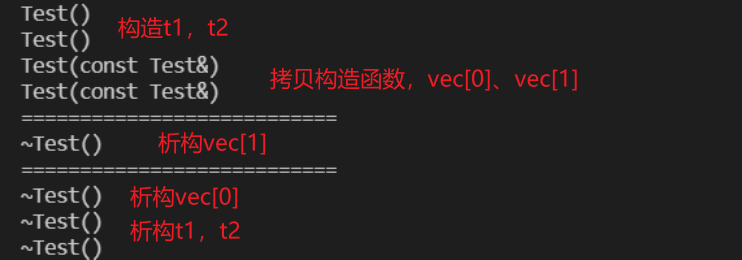深入C++04:模板编程
模板编程
函数模板
模板意义:对类型也进行参数化;
函数模板:是不编译的,因为类型不知道
模板的实例化:函数调用点进行实例化,生成模板函数
模板函数:这才是要被编译器所编译的
函数模板、模板的特例化、非模板函数(普通函数):函数模板只是一个模板,模板特例化是明确类型,还有普通函数;三者不是重载关系;
模板代码是不可以在一个文件中定义,在另一个文件中使用的;模板代码调用之前,一定要看到模板定义的地方,这样的化,模板才能够进行正常的实例化,产生能够被编译器编译的代码;所以,模板代码都是放在头文件中,然后源文件当中直接进行#include包含(#include会展开代码)
类模板
利用类模板实现的顺序栈
#include<iostream>
#include<cstring>
template<typename T>
class SeqStack {
public:
SeqStack(int size = 10) //构造函数
: _pstack(new T[size])
, _top(0) //top一开始就指向空的地方,所以后面也是一直要指向空的地方
, _size(size)
{}
~SeqStack() { //析构函数
delete []_pstack;
_pstack = nullptr;
}
SeqStack<T>(const SeqStack<T> &stack) { //拷贝构造函数
_pstack = new T[stack._size];
_top = stack._top;
_size = stack._size;
for (int i = 0; i < _size; i++) {
_pstack[i] = stack._pstack[i];
}
}
SeqStack<T> operator=(const SeqStack<T> &stack) { //赋值函数重载
if (stack == *this) return *this;
delete _pstack;
T *_newstack = new T[stack._size];
for (int i = 0; i < stack._size; i++) {
_newstack[i] = stack._pstack[i];
}
_pstack = _newstack;
_size = stack._size;
_top = stack._top;
return *this;
}
void push(const T &val) {
if (full()) resize();
_pstack[_top++] = val;
}
void pop() {
if (empty()) return;
--_top;
}
T top() const {
if (empty()) throw "stack is empty!";//抛出异常也属于函数逻辑结束,不需要和返回值一致
return _pstack[_top - 1];
}
bool full() const {
return _top == _size;
}
bool empty() const {
return _top == 0;
}
private:
T *_pstack;
int _top;
int _size;
void resize() {//扩容函数
T *newstack = new T[_size * 2];
for (int i = 0; i < _size; i++) {
newstack[i] = _pstack[i];
}
_size = _size * 2;
delete []_pstack;
_pstack = newstack;
}
};
int main() {
SeqStack<int> test;
for (int i = 0; i < 20; i++) {
test.push(i);
}
for (int i = 0; i < 20; i++) {
std::cout << test.top() << std::endl;
test.pop();
}
return 0;
}
实现vector模板
#include<iostream>
template<typename T>
class vector {
public:
vector<T>(int size = 10)
: _first(new T[size])
, _last(_first)
, _end(_first + size)
{}
~vector<T>() {
delete []_first;
_first = _last = _end = nullptr;
}
vector<T>(const vector<T> &other) {
int size = other._end - other._first;
_first = new T[size];
int len = other._last - other._first;
for (int i = 0; i < len; i++) {
_first[i] = other._first[i];
}
_last = _first + len;
_end = _first + size;
}
vector<T>& operator=(const vector<T> &other) {
if (*this = other) return *this;
delete []_first;
int size = other._end - other._first;
_first = new T[size];
int len = other._last - other._first;
for (int i = 0; i < len; i++) {
_first[i] = other._first[i];
}
_last = _first + len;
_end = _first + size;
return *this;
}
void push_back(const T &val) { //向容器末尾添加元素
if (full()) resize();
*_last = val;
_last++;
}
void pop_back() {//从容器末尾删除元素
if (empty()) return;
_last--;
}
T back() const { //返回容器末尾元素
if (empty()) throw "no value";
return *(_last - 1);
}
bool full() const { return _last == _end; }
bool empty() const { return _first == _last; }
int size() const {return _last - _first;}
private:
T *_first;//数组起始位置
T *_last;//数组中有效元素的后继位置
T *_end;//数组中有效空间的后继位置
void resize() {//2倍扩容操作
int len = _end - _first;
T *newvector = new T[len * 2];
for (int i = 0; i < len; i++) {
newvector[i] = _first[i];
}
delete []_first;
_first = newvector;
_last = _first + len;
_end = _first + len * 2;
}
};
int main() {
vector<int> test;
for (int i = 0; i < 20; i++) {
test.push_back(i);
}
for (int i = 0; i < 20; i++) {
std::cout << test.back() << std::endl;
test.pop_back();
}
return 0;
}
空间配置器
上述vector模板的两个问题:
①在创建类test作为vector的对象的时候,系统默认使用了十次所存对象的构造函数(默认构造十个对象),new不仅开辟了空间,同时也生成了对象!(这样很浪费,比如用户要初始化vector一万次,实际只用一个,浪费了创建的9999个对象额外的内存和时间(内存指的是对象指向的堆内存,而存对象所需要的内存在vector里面是必须一开始就要申请的))
②创建了多少个对象就会析构多少次,上述创建那么多个对象,肯定也会析构那么多次,浪费时间;而如果把内存呢开辟和对象构造分开处理,析构的时候直接采用delete的话:只析构_first,那么只析构了这个指针所指的对象;而析构[] _first,析构会死循环,后面有内存但是不是对象;
应该:

③push_back的时候,里面原本就有对象了的,只是更改了指向,原存在的对象会丢弃,造成内存泄漏
④pop_back的时候只是_last--,没有析构对象,对象中可能还有堆空间,会找不到的;(应该要调用对象的析构函数);但是如果单纯的使用delete,不仅不会调用析构函数析构该位置的对象,还会删除该位置的内存
容器的空间配置器四件事情:内存开辟/内存释放,对象构造/对象析构;
代码:
#include<iostream>
using namespace std;
//实现自己的空间配置器
template<typename T>
class Allocator { //class
public:
T *allocate(size_t size) {//分配内存
return (T*)malloc(sizeof(T) * size);
}
void deallocate(T *p) {//释放内存
free(p);
}
void construct(T *p, const T &val) {//对象构造,明确是传入指针和引用
new (p) T(val); //定位new,指定new的区域,同时采用拷贝构造函数生成对象;
}
void destroy(T *p) {//对象析构
p->~T(); //~T()代表了T类型的析构函数;
}
};
template<typename T, typename Alloc = Allocator<T> >
class vector {
public:
vector(int size = 10) //构造函数
: _first(_allocator.allocate(size) )
, _last(_first)
, _end(_first + size)
{}
~vector() {
for (T *p = _first; p != _last; p++) {
_allocator.destroy(p);//析构有效对象
}
_allocator.deallocate(_first);//释放所有空间
_first = _last = _end = nullptr;
}
vector(const vector<T> &other) { //拷贝构造函数
int size = other._end - other._first;
// _first = new T[size];
_allocator.allcoate(size);
int len = other._last - other._first;
for (int i = 0; i < len; i++) {
// _first[i] = other._first[i];
_allocator.construct(_first + i, other._first[i]); //构造对象
}
_last = _first + len;
_end = _first + size;
}
vector& operator=(const vector<T> &other) {
if (*this = other) return *this;
// delete []_first;
//和析构的一样
for (T *p = _first; p != _last; p++) {
_allocator.destory(p);//析构有效对象
}
_allocator.deallocate(_first);//释放所有空间
//和拷贝构造的一样
int size = other._end - other._first;
int len = other._last - other._first;
_allocator.allcoate(size);
for (int i = 0; i < len; i++) {
_allocator.construct(_first + i, other._first[i]);
}
_last = _first + len;
_end = _first + size;
return *this;
}
void push_back(const T &val) { //向容器末尾添加元素
if (full()) resize();
_allocator.construct(_last, val);
_last++;
}
void pop_back() {//从容器末尾删除元素
if (empty()) return;
_allocator.destroy(--_last);
}
T back() const { //返回容器末尾元素
if (empty()) throw "no value";
return *(_last - 1);
}
bool full() const { return _last == _end; }
bool empty() const { return _first == _last; }
int size() const {return _last - _first;}
private:
T *_first;//数组起始位置
T *_last;//数组中有效元素的后继位置
T *_end;//数组中有效空间的后继位置
Alloc _allocator;//定义容器空间配置器对象!!!!!
void resize() {//2倍扩容操作
int len = _end - _first;
// T *newvector = new T[len * 2];
T *newvector = _allocator.allocate(2 * len);
for (int i = 0; i < len; i++) {
// newvector[i] = _first[i];
_allocator.construct(newvector + i, _first[i]);
}
// delete []_first;
for (T *p = _first; p != _last; p++) {
_allocator.destroy(p);
}
_allocator.deallocate(_first);
_first = newvector;
_last = _first + len;
_end = _first + len * 2;
}
};
struct Test {
Test() {
cout << "Test()" << endl;
}
~Test() {
cout << "~Test()" << endl;
}
Test(const Test &t) {
cout << "Test(const Test&)" << endl;
}
Test& operator=(const Test& t) {
cout << "operator=(const Test&)" << endl;
}
};
int main() {
Test t1;
Test t2;
vector<Test> vec;
vec.push_back(t1);
vec.push_back(t2);
cout << "===========================" << endl;
vec.pop_back();
cout << "===========================" << endl;
return 0;
}

深入C++04:模板编程的更多相关文章
- c++模板编程-typename与class关键字的区别
最近一直在研究c++模板编程,虽然有些困难,但希望能够坚持下去.今天,在书上看见一个讨论模板编程typename与class两个关键字的区别,觉得挺有意义的,就把它们给总结一下. 先看一个例子: te ...
- 实训任务04 MapReduce编程入门
实训任务04 MapReduce编程入门 1.实训1:画图mapReduce处理过程 使用有短句“A friend in need is a friend in deed”,画出使用MapReduce ...
- Hyper-v UBUNTU 12.04 模板设置
Ubuntu 12.04 模板设置 参考文档 Hyper-v安装ubuntu http://blogs.msdn.com/b/virtual_pc_guy/archive/2012/05/02/ubu ...
- C++ 11可变参数接口设计在模板编程中应用的一点点总结
概述 本人对模板编程的应用并非很深,若要用一句话总结我个人对模板编程的理解,我想说的是:模板编程是对类定义的弱化. 如何理解“类定义的弱化”? 一个完整的类有如下几部分组成: 类的名称: 类的成员变量 ...
- C++模板编程中只特化模板类的一个成员函数
模板编程中如果要特化或偏特化(局部特化)一个类模板,需要特化该类模板的所有成员函数.类模板中大多数成员函数的功能可能是一模一样的,特化时我们可能只需要重新实现1.2个成员函数即可.在这种情况下,如果全 ...
- C++之模板编程
当我们越来越多的使用C++的特性, 将越来越多的问题和事物抽象成对象时, 我们不难发现:很多对象都具有共性. 比如 数值可以增加.减少:字符串也可以增加减少. 它们的动作是相似的, 只是对象的类型不同 ...
- Django 04 模板标签(if、for、url、with、autoeacape、模板继承于引用、静态文件加载)
Django 04 模板标签(if.for.url.with.autoeacape.模板继承于引用.静态文件加载) 一.if.for.url.with.autoescape urlpatterns = ...
- c++ 基于Policy 的 模板编程
在没真正接触c++ 模板编程之前.真的没有想到c++ 还能够这么用.最大的感触是:太灵活了,太强大了. 最初接触模板威力还是在Delta3d中,感觉里面的模板使用实在是灵活与方便,特别是dtAI中使 ...
- C++模板编程中只特化模板类的一个成员函数(花样特化一个成员函数)
转自:https://www.cnblogs.com/zhoug2020/p/6581477.html 模板编程中如果要特化或偏特化(局部特化)一个类模板,需要特化该类模板的所有成员函数.类模板中大多 ...
随机推荐
- 微信小程序时间戳转为日期格式
通常后台传递过来的都是时间戳,但是前台展示不能展示时间戳.就需要转化了. 功能说明: 微信小程序里,时间戳转化为日期格式,支持自定义. 拷贝至项目utils/utils.js中,并注意在js中声明下: ...
- Git使用方法以及出现的bug解决方案
git常用命令 1.本地库初始化: git init 2.设置签名 (1)项目级别(项目里面) git config user.name xxx git config user.email xxx ( ...
- Python网络爬虫 - 爬取中证网银行相关信息
最终版:07_中证网(Plus -Pro).py # coding=utf-8 import requests from bs4 import BeautifulSoup import io impo ...
- 面试官:说一说Zookeeper中Leader选举机制
哈喽!大家好,我是小奇,一位不靠谱的程序员 小奇打算以轻松幽默的对话方式来分享一些技术,如果你觉得通过小奇的文章学到了东西,那就给小奇一个赞吧 文章持续更新 一.前言 今天又是一个阳光明媚的一天,我又 ...
- 从实例学习 Go 语言、"并发内容" 学习笔记及心得体会、Go指南
第一轮学习 golang "并发内容" 学习笔记,Go指南练习题目解析.使用学习资料 <Go-zh/tour tour>.记录我认为会比较容易忘记的知识点,进行补充,整 ...
- Java学习day6
今天跟着教学视频做了个简易的学生管理系统 在编写完全部代码之后出现了在空白处右键没有run as选项的问题,通过csdn与博客园上的多个帖子介绍,得知是jdk配置不对,正确配置后问题得到解决 明天学习 ...
- 不借助 Javascript,利用 SVG 快速构建马赛克效果
之前在公众号转发了好友 Vajoy 的一篇文章 -- 巧用 CSS 把图片马赛克风格化. 核心是利用了 CSS 中一个很有意思的属性 -- image-rendering,它可以用于设置图像缩放算法. ...
- Jx.Cms开发笔记(六)-重写Compiler
我们在Jx.Cms开发笔记(三)-Views主题动态切换中说了如何切换主题.但是这里有一个问题,就是主题切换时,会报错 这是由于asp.net core在处理Views的信息的时候是在构造函数中处理的 ...
- BUUCTF-Web:[GXYCTF2019]Ping Ping Ping
题目 解题过程 1.题目页面提示?ip=,猜测是让我们把这个当做变量上传参数,由此猜想是命令注入 2.用管道符加上linux常用命令ls(windwos可以尝试dir)试试 所谓管道符(linux)的 ...
- XCTF练习题---MISC---reverseMe
XCTF练习题---MISC---reverseMe flag:flag{4f7548f93c7bef1dc6a0542cf04e796e} 解题步骤: 1.观察题目,下载附件 2.拿到手以后发现是个 ...
